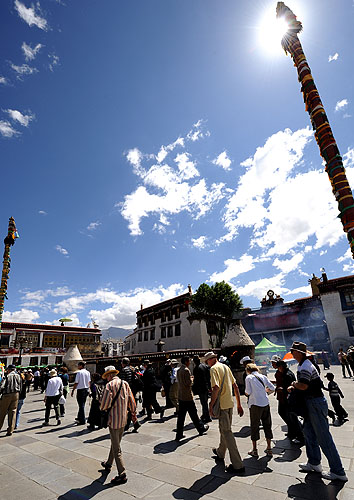|
 |
|
HOLY PALACE: Tourists visit Lhasa's Jokhang Temple. Tibet welcomed more than 720,000 tourists from January to May 2009 (KELSANG DAWA) |
General Manager Fu Lin said the company found its water source 10 years ago but did not exploit it because of undeveloped transportation. The company was set up in October 2005 just before the railway started operating. It began producing its brand of mineral water, 5100, in 2006.
"The annual mineral water resources here are 3.6 million tons, while 1.2 million tons can be tapped. Without the Qinghai-Tibet Railway, there would be no 5100 Mineral Water," said Fu. He said the company's annual output in 2006 was only 4,000 tons but reached 50,000 tons in 2008 because of the railway. He said annual output in 2009 could reach 120,000 tons.
"We are planning a third production line. After it is put into operation, our total capacity will be able to reach 300,000 tons," said Fu.
According to CTRC, the cost of both passenger and goods transport has been greatly reduced with the completion of the railway. The cost per ton-km has been reduced from 0.38 yuan ($0.056) to 0.12 yuan ($0.018).
"Shippers of 1 ton of goods can save more than 500 yuan ($73.21) in transportation costs from Lhasa to Xining," said Fu. "Our products are delivered to other inland cities over the railway."
By 2010, it is projected that 2.8 million tons of cargo will be carried to and from Tibet, with over 75 percent of that being carried by the railway.
The transport cost reduction has improved the competitiveness of Tibetan products and promoted the development of Tibetan industries. Today, many Tibetan products, including mineral water, beers and yak milk, are crowding into Chinese markets thanks to the railway.
Damxung County used to be a poverty-stricken area lacking any industry. But the establishment of the Tibet Glacier Mineral Water Co. improved local people's lives.
In 2008, the company's output was valued at nearly 300 million yuan ($43.92 million), accounting for 98 percent of the total annual output in Damxung. Output in 2009 is expected to reach 500 million yuan ($73.21 million), said Fu.
He said the company has 230 staff members, with over 95 percent being local Tibetans. Lobsang, a 24-year-old, has been working with the company since it started operations. Her five-member family's annual income used to be 1,000 yuan ($146.41). Since she started working with the company, her yearly income alone can reach up to 40,000 yuan ($5,857). "Today, I can easily pay my brother's and sister's studying fees," she said.
Statistics from CTRC show that Tibet's gross domestic product growth in 2007 and 2008 was 14 percent and 10.1 percent, respectively.
Also since the Qinghai-Tibet Railway began operating, many world-known corporations have invested in Tibet, said Dorbyge, Director of the Tibet Investment Promotion Bureau.
Tibet Glacier Mineral Water Co. Ltd. is invested by a Hong Kong company, with Carlsberg International and China International Trade and Investment Corp. as business partners, according to Dorbyge.
Besides, those corporations include China Minmetals Corp., a large group dealing worldwide in development, production, trading and operation for metals and minerals, and China Metallurgical Group Corp., a leading multidisciplinary multinational company that is well-known for its rewarding experience and strengths in scientific research, industrial engineering practice and international trading capabilities, said Dorbyge.
Between 2002 and 2008, Tibet attracted about 16.2 billion yuan ($2.37 billion) of investment. The operation of the Qinghai-Tibet Railway has boosted Tibet's regional ties, promoted its structural adjustment and helped it develop.
Tourism rush
Tourism is playing an increasingly important role in Tibet's economy.
"Traffic is a basic guarantee for the development of tourism," said Thupten Khedrup, a professor with Tibet University's College of Tourism and Foreign Languages.
The establishment of the Qinghai-Tibet Railway has broken a traffic bottleneck that used to restrict the development of the plateau's tourism industry.
Since the link's completion, Tibet's tourism has entered a period of rapid development.
In 2007 Tibet received more than 4 million domestic and foreign tourists, realizing tourism revenues of 4.8 billion yuan ($702.78 million). And although Tibet's tourism industry was hurt by the March 14 riot in Lhasa, the year still saw 2.25 million domestic and foreign tourists visiting Tibet. Tourism revenue in 2008 reached 2.3 billion yuan ($330.75 million), almost equaling the total revenue generated between 1980 and 2000.
"Without the Qinghai-Tibet Railway, there would be no such prosperity in the tourism industry," said Thupten Khedrup.
Tibet has formed a solid tourism footprint, with Lhasa as the center, supplemented by Xigaze, Shannan and Nyingchi, and extending to Nagqu, Ngari and Qamdo, said Wang Songping, Deputy Director of the Tibet Autonomous Region Tourism Administration.
Seeing the success of the railroad, the Central Government has approved two projects that will extend service on the Qinghai-Tibet Railway, including adding a Lhasa-Xigaze line and a Lhasa-Nyingchi line, Wang said. The two extensions are planned to be completed by 2020.
"After that day, the two extension lines will bring more opportunities and vitality to Tibet tourism," Wang said.
Tibet's tourism industry is also playing an increasingly significant role in boosting employment and tax revenue, as well as raising the living standards of both urban and rural residents.
With the inflow of domestic and foreign tourists, Tibet's tourism has developed significantly and inspired the development of hotels, catering and tourist infrastructure. From 2006 to 2008, Tibet brought in 10.3 billion yuan ($1.51 billion) in tourism income, according to official statistics. | 